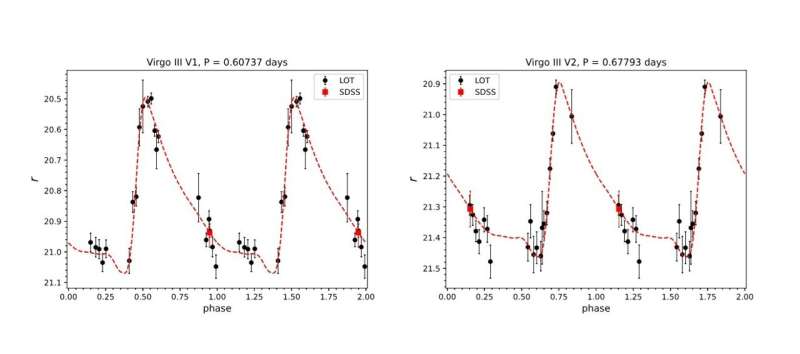May 16, 2024 report
This article has been reviewed according to Science X's editorial process and policies. Editors have highlighted the following attributes while ensuring the content's credibility:
fact-checked
preprint
trusted source
proofread
Three new RR Lyrae variable stars discovered

Using the Lulin One-meter Telescope (LOT), astronomers have observed a newly detected candidate ultra-faint dwarf galaxy known as Virgo III. As a result, they discovered three new RR Lyrae variable stars in the vicinity of this galaxy. The finding was reported in a research paper published May 9 on the pre-print server arXiv.
Variable stars could offer important hints into aspects of stellar structure and evolution. They could also help us better understand the distance scale of the universe. In particular, the so-called RR Lyrae (RRL) variables are a powerful tool for studying the morphology, metallicity and age of galaxies, especially those with low surface brightness. In general, RRLs are pulsating horizontal branch (HB) stars of spectral class A or F, with a mass of around half the sun's.
Discovered in 2023, Virgo III is a candidate ultra-faint dwarf (UFD) galaxy with a V -band absolute magnitude of approximately -2.69 mag. The galaxy has a half-light radius of about 1 arcminute and may host many variable stars.
Astronomers Chow-Choong Ngeow of the National Central University in Taiwan and Anupam Bhardwaj of the Inter-University Center for Astronomy and Astrophysics (IUCAA) in India, has conducted a search for potential RR Lyrae variables in the vicinity of Virgo III.
"In this work, we searched for RR Lyrae in Virgo III using the time-series LOT observations. (...) LOT is a F/8 Cassegrain reflector, and it was equipped with the Andor iKon-L 936 CCD imager during our queued observations," the researchers wrote.
The observations resulted in the detection of two fundamental mode (ab-type) and one first-overtone (c-type) RR Lyrae stars. In general, the three newfound variables, designated V1, V2, and V3, have periods (between 0.43 and 0.68 days) and amplitudes (0.267–0.574 mag) consistent with the known RRLs in globular clusters.
The three RRLs are located within the four times the half-light radius of Virgo III, and have similar distance modulus as this galaxy. Therefore, the astronomers assume that they all are members of Virgo III, however future radial velocity measurements are required in order to confirm this.
If V1-V3 are indeed Virgo III members, the researchers estimate that the distance to this galaxy is approximately 502,000 light years, which is consistent with measurements provided by previous observations. Based on the two ab-type RRLs, the authors of the paper also calculated the metallicity of Virgo III, which was found to be at a level of -1.93 dex.
Further studies are needed to provide more insights into the properties of the three newly discovered RR Lyrae stars and to validate the UFD status of Virgo III.
More information: Chow-Choong Ngeow et al, Discovery of RR Lyrae in the Ultra-Faint Dwarf Galaxy Virgo III, arXiv (2024). DOI: 10.48550/arxiv.2405.05482
Journal information: arXiv
© 2024 Science X Network





















